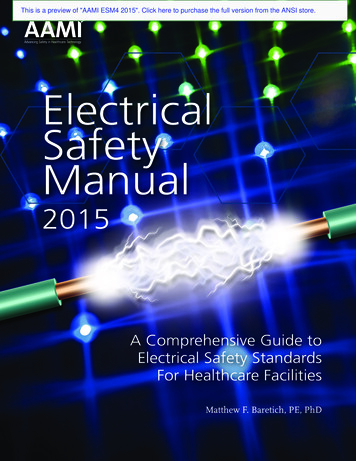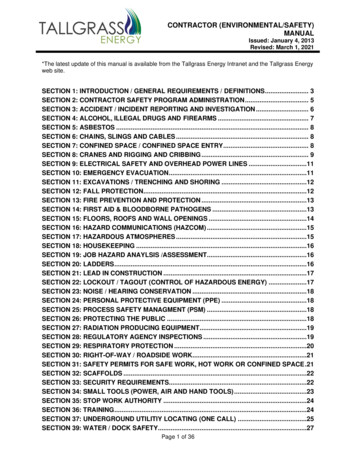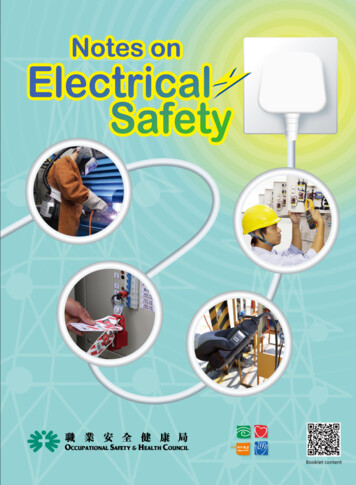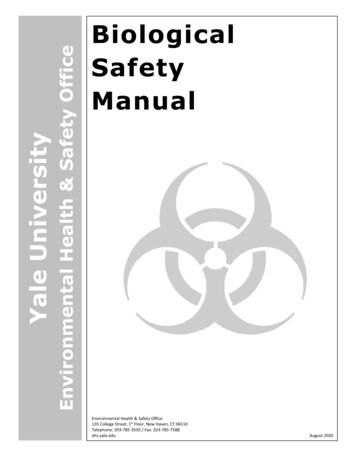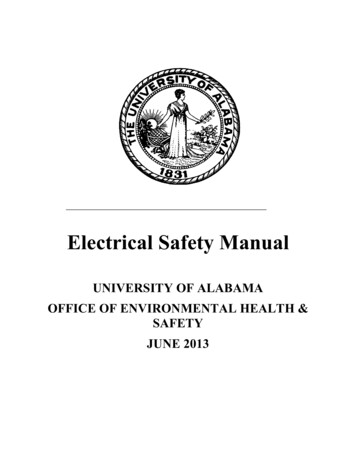
Transcription
Electrical Safety ManualUNIVERSITY OF ALABAMAOFFICE OF ENVIRONMENTAL HEALTH &SAFETYJUNE 2013
Table of Contents1. Introductiona) Purposeb) Scopec) References Utilized2. Definitions3. Responsibilitiesa) UA Administrationb) Environmental Health and Safety (EHS)c) Supervisorsd) Employees4. Traininga) Requirements - Qualified Electrical Workerb) Documentation of Training and Experience5. Basic Electrical Safety Principles for Energized Condition6. Portable Electrical Equipment and Extension Cords7. Requirements for Temporary Wiring8. Wet or Damp Locations9. Working on De-energized Equipment (Electrically Safe Conditions)10. Lockout/Tagout Programa) Individual qualified-employee control procedureb) Complex lockout/tagout proceduresc) Removal of lockout/tagout devicesd) Return to servicee) Temporary release11. Working on or Near Energized Equipmenta) Energized Electrical Work Permit For 240 Volts And Higherb) Approach Distances To Live Parts12. Equipment Labelinga) Implementation Procedures13. Arc Flash Hazard Analysis14. Personal Protective Equipmenta) General Requirementsb) Protective Clothing Characteristicsc) Flame-Resistant Apparel & Under Layersd) Rubber Insulating Equipmente) Insulated Tools and Materials15. Access Limiting Equipment16. Approach Boundaries17. Vehicular and Mechanical Equipmenta) Elevated Equipmentb) Equipment Contactc) Equipment Grounding
1. IntroductionThis program establishes minimum standards to prevent hazardous electrical exposures topersonnel and ensure compliance with regulatory requirements applicable to electrical systems.Working on equipment in a de-energized state is required unless de-energizing introduces anincreased hazard or is infeasible. This program is designed to help ensure that energizedelectrical work at The University of Alabama is performed safely by qualified electrical workers,who are trained and provided with the appropriate safe work procedures, protective equipmentand other controls. The program is intended to protect employees against electrical shock, burnsand other potential electrical safety hazards as well as comply with regulatory requirements.a) PurposeThis program has been established in order to: Ensure the safety of employees who may work on or near electrical equipment. Ensure that employees understand and comply with safety standards related toelectrical work. Ensure that personnel follow consistent practices during the progress of electricalwork. Comply with recognized safety practices according to the following six points:1) Provide and demonstrate a safety program with defined responsibilities.2) Determine the degree of arc flash hazard by qualified personnel.3) Affix warning labels on equipment.4) Provide personal protective equipment (PPE) for workers.5) Provide documented training6) Provide appropriate tools for safe work.b) ScopeThis program applies to all work performed by UA personnel regardless of job sitelocation.c) References UtilizedNFPA 70-E, “Standard for Electrical Safety in the Workplace”IEEE Standard, “Guide for Performing Arc Flash Hazard Calculations”OSHA 29 CFR 1910.331 through 1910.335, “Electrical Safety-Related Work Practices”OSHA 29 CFR 1910.147, “The Control of Hazardous Energy (Lockout/Tagout)”2. DefinitionsDefinitions are provided to clarify terms and provide additional resource information.Authorized Lockout/Tagout Employee - A person who has completed the required hazardousenergy control training and is authorized to lockout or tagout a specific machine or equipment toperform service or maintenance. A person must be certified as an Authorized Lockout/TagoutEmployee in order to apply a lock or tag to control hazardous energy. All AuthorizedLockout/Tagout Employees must be trained in electrical safety and lockout/tagout.
De-energized electrical work - Electrical work that is performed on equipment that has beenpreviously energized and is now free from any electrical connection to a source of potentialdifference and from electrical charges.Disconnecting (or Isolating) switch - A device designed to close and/or open an electric circuit.Energized electrical work - Repair, maintenance, troubleshooting, or testing on electricalcircuits, components, or systems while energized (i.e., live). Only Qualified Electrical Workersare permitted to work on energized circuitry of 50 volts/25 amps to ground or greater.Energy source - Any source of electrical, mechanical, hydraulic, pneumatic, chemical, thermal,or other energy.Exposed electrical parts - Energized parts that can be inadvertently touched or approachednearer than a safe distance by a person. Parts not suitably guarded, isolated, or insulated.Examples include terminal contacts or lugs, and bare wiring.Flash Protection Boundary - An approach limit distance from exposed live parts within whicha person could receive a second degree burn if an electrical arc flash were to occur.Ground Fault Circuit Interrupt (GFCI) - A device whose function is to interrupt the electriccircuit to the load when a fault current to ground exceeds a predetermined value that is less thanthat required to operate the over-current protective device of the supply circuit.Ground - A conducting connection, whether intentional or accidental, between an electricalcircuit or equipment and the earth or to some conducting body that serves in place of the earth.Hazardous Location - An area in which an airborne flammable dust, vapor or gas may bepresent and would represent a hazard if a source of ignition were present (see National FireProtection Association (NFPA).Interlock - An electrical, mechanical, or key-locked device intended to prevent an undesiredsequence of operations.Isolating Switch - A switch intended for isolating an electric circuit from the source of power. Ithas no interrupting rating, and is intended to operate only after the circuit has been opened bysome other means.Life Safety Equipment - Equipment that provides critical protection for safety in the event of anemergency or other serious hazard. Life safety equipment, which is electrically energized, shouldbe worked on using Energized Electrical Equipment procedures to ensure that the protectionprovided by the equipment is not lost (e.g., fire alarm and evacuation).Limited Approach Boundary – An approach limit is a distance from an exposed live partwithin which a shock hazard exists.
Lockout - The placement of a lock on an energy-isolating device according to procedure,ensuring that the energy isolating device and the equipment being controlled cannot be operateduntil the lockout device is removed.Lockout /Tagout - A standard that covers the servicing and maintenance of machines andequipment in which the unexpected re-energization of the equipment or release of stored energycould cause injury to employees. It establishes performance requirements for the control of suchhazardous energy.NEC – National Electrical Code which is also referenced as NFPA 70.Prohibited Approach Boundary – An approach limit distance from an exposed live part withinwhich work is considered the same as making contact with the live part.Qualified Electrical Worker – A qualified person trained and knowledgeable of constructionand operation of equipment or a specific work method and is trained to recognize and avoid theelectrical hazards that might be present with respect to that equipment or work method.Qualified electrical workers shall be familiar with the proper use of the specialprecautionary techniques, personal protective equipment (PPE), including arc-flash,insulating and shielding materials, and insulated tools and test equipment.An employee who has completed all applicable coursework training and is undergoingon-the-job training is a “Qualified Electrical Worker in Training”. A Qualified ElectricalWorker in Training who has performed duties safely at his or her level of training andwho is under the direct supervision of a qualified person shall be considered a “QualifiedElectrical Worker”.Only a Qualified Electrical Worker is allowed to work within the limited approachboundary of exposed energized electrical conductors and circuit parts operating at 50volts or more.Qualified electrical workers shall not be assigned to work alone, except for replacingfuses, operating switches, or other operations that do not require the employee to contactenergized high voltage conductors or energized parts of equipment, clearing trouble, oremergencies involving hazard to life or property.Whether a person is considered to be a “qualified” person will depend upon variouscircumstances in the workplace. It is possible and, in fact, likely for an individual to beconsidered “qualified” with regard to certain equipment in the workplace, but“unqualified” as to other equipment. Tasks that are performed less often than once peryear shall require retraining before the performance of the work practices involved.Retraining must be provided for all Qualified Electrical Workers and additional trainingshall be provided anytime an employee is not complying with the safety-related workpractices. Additionally training must be provided anytime new technology, new
equipment or changes in procedures necessitate any changes in the normal workpractices.Restricted Approach Boundary – An approach limit distance from an exposed live part withinwhich there is an increased risk of shock, due to electrical arc-over combined with inadvertentmovement, for personnel working in close proximity to the live part.Remote-control Circuit - Any electric circuit that controls any other circuit through a relay oran equivalent device.Service - The conductors and equipment for delivering energy from the electricity supply systemto the wiring system of the premises served.Service Equipment - The necessary equipment, usually consisting of a circuit breaker or switchand fuses, and their accessories, located near the entrance of supply conductors to the buildingand intended to constitute the main control and means of cutoff of the supply.Setting Up - Any work performed to prepare a machine or equipment to perform its normalproduction operation.Switching Devices - Devices designed to close and/or open one or more electric circuits.Included in this category are circuit breakers, cutouts, disconnecting (or isolating) switches,disconnecting means, interrupter switches, and oil (filled) cutouts.Tagout - The placement of a tagout device on an energy-isolating device according to procedureto indicate that the equipment may not be operated until the tagout device is removed.Voltage (of a circuit) - The greatest root-mean-square (effective) difference of potential betweenany two conductors of the circuit concerned.Voltage, high - Circuits with a nominal voltage more than 50 volts.Voltage, low - Circuits with a nominal voltage less than or equal to 50 volts.Voltage, nominal - An approximate value assigned to a circuit or system for the purpose ofconveniently designating its voltage class, e.g., 120/240, 480/277, and 600.Wet location - Installations subject to saturation with water or other liquids.3. Responsibilitiesa) The University of Alabama Administration Promote employee safety by providing direction and support for the Electrical SafetyProgram. Promote consistency in how electrical tasks are completed safely within the variousfacilities of campus. Place an emphasis on controlling electrical hazards through the application ofengineering and design controls.
Provide arc flash analyses required by this program, as needed and during equipmentreplacement or upgrading.b) Environmental Health and Safety (EHS) Periodically review and update this written program. Provide or coordinate general training for work units on the content of this program. Evaluate the overall effectiveness of the electrical safety program on a periodic basis. Assist work units in the implementation of this program. Provide or assist in the task of specific training for electrical work qualifications. Maintain training documentation through recordkeeping. Training documentationwill contain content of the training, each employee’s name and dates of training.Documentation of training shall be made when the employee demonstratesproficiency in the work practices involved. Evaluate work being performed and determine compliance with this program(through inspections conducted on at least an annual basis).c) Supervisors Promote electrical safety awareness to all employees. Ensure employees comply with ALL provisions of the electrical safety program. Ensure employees receive training appropriate to their assigned electrical tasks andmaintain documentation of such training. Maintain documentation of Qualified Electrical Workers in Training and theQualified Electrical Worker they work with while undergoing on-the-job training. Develop and maintain a listing of all qualified employees under their supervision. Ensure employees are provided with and use appropriate protective equipment. During supervision, evaluate work being performed and that each employee iscomplying with the safety-related work practices.d) Employees Follow the work practices described in this document, including the use ofappropriate protective equipment and tools. Attend all required training. Immediately report any concerns related to electrical safety to supervision.4. TrainingWorkers near energized, or potentially energized electrical circuitry of fifty (50) volts to groundor greater, shall be trained in energized electrical safe work practices and procedures andretrained annually.a) Requirements – Qualified Electrical WorkerEmployees must receive training in avoiding the electrical hazards associated withworking on or near exposed energized parts prior to performing energized electricalwork. Such training will be provided when the employee is initially assigned to the joband refresher training will be provided every year, or anytime an employee is notcomplying with the safety-related work practices. Additional training must be provided
anytime new technology; new equipment or when conditions change that necessitates achange in the normal work practices.The following items are to be included in the training of Qualified Electrical Workers: Demonstrate a working knowledge of the National Electrical Code. The Lockout/Tagout Training Program including safe work practices required tosafely de-energize electrical equipment. Universal electrical safety procedures. Skills and techniques necessary to distinguish exposed live parts from other parts ofelectric equipment. Perform on-the-job training with a qualified electrical worker. Skills and techniques necessary to determine the nominal voltage of exposed liveparts. The approach distances specified in Appendix A and the corresponding voltages towhich the qualified electrical worker will be exposed. Selection and use of proper work practices, personal protective equipment, tools,insulating and shielding materials and equipment for working on or near energizedparts. Basic Cardio Pulmonary Resuscitation (CPR) Automatic External Defibrillator (AED) Contacting emergency personnel and basic first aidb) Documentation of Training and ExperienceDocumentation of training shall be maintained by each shop and EHS. Experiencereceived by Qualified Electrical Workers must be documented. Documentation isnecessary to demonstrate that individuals have met the training and experiencerequirements for the types of work being performed.5. Basic Electrical Safety Principles for Energized ConditionBasic electrical safety principles should be followed anytime an energized electrical conditionexists. De-energize whenever possible. Plan every job. The approach and step-by-step procedures to complete the work athand must be discussed and agreed upon between all involved employees beforebeginning. Identify the hazards. Conduct a job hazard analysis. Identify steps that could createelectric shock or arc-flash hazards. Minimize the hazards. De-energize any equipment, and insulate, or isolate exposedlive parts so contact cannot be made. If this is impossible, obtain and wear properpersonal protective equipment (PPE) and tools. Anticipate problems. If it can go wrong, it might. Make sure the proper PPE andtools are immediately available and worn by employees. Obtain training. Make sure all involved employees are qualified electrical workerswith appropriate training for the job.
6. Portable Electrical Equipment and Extension CordsThe following requirements apply to the use of cord-and-plug-connected equipment and flexiblecord sets (extension cords): Extension cords may only be used to provide temporary power. Portable cord and plug connected equipment and extension cords must be visuallyinspected before use on any shift for external defects such as loose parts, deformedand missing pins, or damage to outer jacket or insulation, and for possible internaldamage such as pinched or crushed outer jacket. Any defective cord or cord-andplug-connected equipment must be removed from service. Extension cords must be of the three-wire type. Extension cords and flexible cordsmust be designed for hard or extra hard usage (for example, types S, ST, and SO).The rating or approval must be visible. Job-made extension cords are forbidden. Personnel performing work on renovation or construction sites using extension cordsor where work is performed in damp or wet locations must be provided, and use, aground-fault circuit interrupter (GFCI). Portable equipment must be handled in a manner that will not cause damage.Flexible electric cords connected to equipment may not be used for raising orlowering the equipment. Extension cords must be protected from damage. Sharp corners must be avoided.Flexible cords may not be run through windows or doors unless protected fromdamage, and then only on a temporary basis. Flexible cords may not be run aboveceilings or inside or through walls, ceilings or floors, and may not be fastened withstaples or otherwise hung in such a fashion as to damage the outer jacket orinsulation. Cords must be covered by a cord protector or tape when they extend into a walkwayor other path of travel to avoid creating a trip hazard. Extension cords used with grounding type equipment must contain an equipmentgrounding conductor (i.e., the cord must accept a three-prong, or grounded plug). Attachment plugs and receptacles may not be connected or altered in any way thatwould interrupt the continuity of the equipment grounding conductor. Additionally,these devices may not be altered to allow the grounding pole to be inserted intocurrent connector slots. Clipping the grounding prong from an electrical plug isprohibited. Flexible cords may only be plugged into grounded receptacles. The continuity of theground in a two-prong outlet must be verified before use. It is recommended that thereceptacle be replaced with a three-prong outlet. Adapters that interrupt thecontinuity of the equipment grounding connection may not be used. All portable electric equipment and flexible cords used in highly conductive worklocations, such as those with water or other conductive liquids, or in places whereemployees are likely to contact water or conductive liquids, must be approved forthose locations. Employee's hands must be dry when plugging and unplugging flexible cords and cordand plug connected equipment if energized equipment is involved.
If the connection could provide a conducting path to employees hands (for example,if a cord connector is wet from being immersed in water), the energized plug andreceptacle connections must be handled only with insulating protective equipment.Locking type connectors must be properly locked into the connector.Lamps for general illumination must be protected from breakage, and metal shellsockets must be grounded.Temporary lights must not be suspended by their cords unless they have beendesigned for this purpose.Portable lighting used in wet or conductive locations, such as tanks or boilers, mustbe operated at no more than 12 volts or must be protected by GFCI’s.Extension cords are considered to be temporary wiring, and must also comply withthe section on “Requirements for Temporary Wiring” in this program.7. Requirements for Temporary WiringTemporary electrical power and lighting installations 600 volts or less, including flexible cords,cables and extension cords, may only be used during and for renovation, maintenance, repair, orexperimental work. The duration for temporary wiring used for decorative lighting for specialevents and similar purposes may not exceed 90 days. The following additional requirementsapply: Ground-fault protection (e.g., ground-fault circuit interrupters, or GFCI) must beprovided on all temporary-wiring circuits, including extension cords, used onconstruction sites. In general, all equipment and tools connected by cord and plug must be grounded.Listed or labeled double insulated tools and appliances need not be grounded. Feeders must originate in an approved distribution center, such as a panel board, thatis rated for the voltages and currents the system is expected to carry. Branch circuits must originate in an approved power outlet or panel board. Neither bare conductors nor earth returns may be used for the wiring of anytemporary circuit. Receptacles must be of the grounding type. Unless installed in a complete metallicraceway, each branch circuit must contain a separate equipment-grounding conductor,and all receptacles must be electrically connected to the grounding conductor. Flexible cords and cables must be of an approved type and suitable for the locationand intended use. They may only be used for pendants, wiring of fixtures, connectionof portable lamps or appliances, elevators, hoists, connection of stationary equipmentwhere frequently interchanged, prevention of transmission of noise or vibration, dataprocessing cables, or where needed to permit maintenance or repair. They may not beused as a substitute for the fixed wiring, where run through holes in walls, ceilings orfloors, where run through doorways, windows or similar openings, where attached tobuilding surfaces, or where concealed behind building walls, ceilings or floors. Suitable disconnecting switches or plug connects must be installed to permit thedisconnection of all ungrounded conductors of each temporary circuit. Lamps for general illumination must be protected from accidental contact or damage,either by elevating the fixture or by providing a suitable guard. Hand lamps suppliedby flexible cord must be equipped with a handle of molded composition or otherapproved material and must be equipped with a substantial bulb guard.
Flexible cords and cables must be protected from accidental damage. Sharp cornersand projections are to be avoided. Flexible cords and cables must be protected fromdamage when they pass through doorways or other pinch points.8. Wet or Damp LocationsWork in wet or damp work locations (i.e., areas surrounded or near water or other liquids) shouldnot be performed unless it is absolutely critical. Electrical work should be postponed until theliquid can be cleaned up. The following special precautions must be incorporated whileperforming work in damp locations: Only use electrical cords that have Ground Fault Circuit Interrupters (GFCIs). Remove standing water before beginning work. Work is prohibited in areas where there is standing water. Place a dry barrier over any wet or damp work surface. Do not use electrical extension cords in wet or damp locations. Keep electrical cords away from standing water.9. Working on De-energized Equipment (Electrically Safe Conditions)The most important principle of electrical safety is to assume all electric circuits are energizedunless each involved worker ensures they are not. Every circuit and conductor must be testedevery time work is done on them. Proper PPE must be worn until the equipment is proven to bede-energized. Voltage rated gloves and leather protectors must be worn Approved insulating mats Electrically insulated shoes should be worn Safety glasses must be worn The required Arc Flash PPE must also be wornThe National Fire Protection Association (NFPA) lists six steps to ensure conditions forelectrically safe work. Identify all sources of power to the equipment. Check applicable up-to-datedrawings, diagrams, and identification tags. Remove the load current, and then open the disconnecting devices for each powersource. Where possible, visually verify that blades of disconnecting devices are fully open orthat drawout-type circuit breakers are fully withdrawn. Apply lockout/tagout devices in accordance with a formal, written policy (AppendixF). Test each phase conductor or circuit part with an adequately rated voltage detector toverify that the equipment is de-energized. Test each phase conductor or circuit partboth phase-to-phase and phase-to-ground. Check the voltage detector before andafter each test to be sure it is working. Properly ground all possible sources of induced voltage and stored electric energy(such as, capacitors) before touching. If conductors or circuit parts that are being deenergized could contact other exposed conductors or circuit parts, apply groundconnecting devices rated for the available fault current.
The process of de-energizing is "live" work and can result in an arc flash due to equipmentfailure. When de-energizing, follow the procedures described in "Working On or Near EnergizedEquipment."10. Lockout/Tagout ProgramThe University of Alabama has developed a separate written lockout/tagout program which isprovided in Appendix F. The program covers planning for locating and labeling energy sources,identifying employees at risk, how and by whom the equipment is de-energized, releasing ofstored energy, verifying that the circuit is de-energized and can't be restarted, voltage testing,grounding requirements, shift changes, coordination with other jobs in progress, a procedure forkeeping track of all involved personnel, applying and removing lockout/tagout devices, return toservice, and temporary re-energizing for testing/positioning. Lockout/tagout procedures shouldbe developed for each machine or piece of equipment that will require servicing. Each personwho could be exposed to electric energy must be involved in the lockout/tagout process.After de-energizing, each employee at risk should apply an individual lockout/tagout device toeach source of electric energy. Pushbuttons or selector switches cannot be used as the only wayto de-energize. A lockout device is a key or combination lock with a tag that can be attached to adisconnecting device to prevent the re-energizing of the equipment being worked on withoutremoval of the lock. The lockout device should have a way of identifying whose lock it is.Individual lockout devices with the employee name and picture on them are preferred. Thatemployee must be the only person who has the key or combination for the lockout device theyinstall, and that employee should be the only person to remove the lock after all work has beencompleted. A tagout device is a tag and a way to attach it that can withstand at least 50 poundsof force. Tagout devices should be used alone only when it is not possible to install a lockoutdevice. The tag used in conjunction with a lockout or tagout device must have a labelprohibiting unauthorized operation of the disconnecting means or unauthorized removal of thedevice.Before beginning work, each involved employee must verify through testing that all energysources have been de-energized. Electric lockout/tagout procedures should be coordinated withall other site procedures for controlling exposure to electric energy and other types of energysources.a) Individual qualified-employee control procedureFor minor servicing, maintenance, inspection, and so on, on plug-connected equipment,work may be done without attaching lockout/tagout devices if the plug is next to wherethe employee is working, is always easy to see, the equipment is never left alone whilebeing serviced, and a lockable cover is placed over the plug with a lock installed on thecover.
b) Complex lockout/tagout proceduresSpecial procedures are needed when there is more than one energy source, crew, craft,location, employer, way to disconnect, or lockout/tagout procedure - or work that lastsbeyond one shift. In any of these cases, one qualified person should be in charge of thelockout/tagout procedure with full responsibility for ensuring all energy sources are underlockout/tagout and to account for all people on the job. Appendix F contains an in-depthwritten plan addressing the specific details of lockout/tagout.c) Removal of lockout/tagout devicesLockout and tagout devices should be removed only by the person installing them. Ifwork is not completed when the shift changes, workers arriving on shift should applytheir locks before departing workers remove their locks.d) Return to serviceOnce work is completed and lockout/tagout devices removed, tests and visual inspectionmust confirm that all tools, mechanical restraints, electric jumpers, shorts, and groundshave been removed. Only then is it safe to re-energize and return to service. Employeesresponsible for operating the equipment and needed to safely re-energize it should be outof the danger zone before equipment is re-energized.e) Temporary releaseIf the job requiring lockout/tagout is interrupted for testing or positioning equipment,follow the same steps as in “Return to service” (above).11. Working on or Near Energized EquipmentWorking on live circuits means actually touching energized parts. Working near live circuitsmeans working close enough to energized parts to pose a risk even though work is on deenergized parts. Common tasks where there may be a need to work on or near live circuitsinclude:
Electrical Safety Manual . UNIVERSITY OF ALABAMA . OFFICE OF ENVIRONMENTAL HEALTH & SAFETY . JUNE 2013 . . and other potential electrical safety hazards as well as comply with regulatory requirements. a) Purpose . previously energized and is now free from any electrical connection to a so



